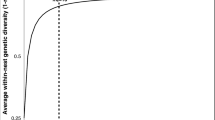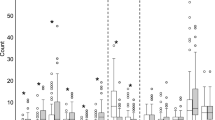Summary
Thirty-seven laboratory colonies (two to six females in each) of a primitively social halictid bee were observed for a total of 13160 min to obtain data on intranidal differentiation in behavior. Nine behavioral patterns or categories were repeated often enough for numerical analysis of the behavior, i.e., ethometrics.
Although the castes are externally indistinguishable and intergrade with one another in ovarian development, the bee with the largest ovaries in each colony shows certain behavioral specializations that justify her designation as queen. She is the most active bee. Pre-eminent among characteristic queen behavioral categories is backing—the queen in every colony backed away from other bees more frequently than any other bee in the colony. Queens are usually maximal nudgers of other bees in the colony, while they are in the low ranks for pollen collecting and guarding. Both backing and nudging are directly related to ovarian size. Other behavioral categories have more complex relationships; e.g., following and guarding are usually minimal for queens and progressively more common for workers with smallest to largest ovaries. Thus the ovarially most queenlike workers are behaviorally the least queenlike for these attributes. The two workers in a colony of three bees are behaviorally different and their counterparts are easily recognizable in larger colonies. The maximal guard, which has ovaries larger than the average for workers, is usually the least active bee, showing minimal backing and minimal working on cells. The maximal pollen collector commonly shows minimal nudging and high passing. She usually has the smallest or nearly the smallest ovaries in the colony. “Other” workers (in colonies of more than three bees) are not specialized as either guards or pollen collectors although they do some of both; they tend to be rather inactive.
A principal components analysis of individuals in colonies of three bees, based on all behavioral characteristics except pollen collecting, clustered the bees into two groups, queens and workers, with guards and foragers at opposite extremes of the worker cluster. A discriminant function (canonical) analysis verified the distinctness of these groups, placing the workers into two clusters; when the “other” workers in colonies of four or more bees were also considered, they mostly fell between, but partially mixed with, foragers and guards.
In 11 out of 12 colonies, removal of queens resulted in another bee (commonly one of the “other” workers) showing queenlike behavior, sometimes noted in less than four hours. Such replacement queens had enlarged ovaries when later dissected; thus caste determination in the adult stage is verified.
It appears as if the bees discriminate among individuals on the basis of ovarian size—for example, the queen concentrates her nudging on the bee with next largest ovaries, commonly the guard. The mechanism by which the queen inhibits ovarian development of her nest mates remains unknown but may be purely mechanical—disturbance by her great activity and frequent nudging of other bees, and drawing bees down, away from the entrance, by her frequent backing.
Oophagy was observed three times when the identity of the layer and egg eater were known. In each case the egg had been laid by a worker and was eaten by a queen.
Similar content being viewed by others
Referenees
Batra, S. W. T.: Behavior of the social bee,Lasioglossum zephyrum, within the nest. Insectes Sociaux11, 159–185 (1964)
Batra, S. W. T.: The life cycle and behavior of the primitively social bee,Lasioglossum zephyrum. Univ. Kansas Sci. Bull.46, 359–423 (1966)
Batra, S. W. T.: Behavior of some social and solitary halictine bees within their nests: a comparative study. J. Kansas Entomol. Soc.41, 120–133 (1968)
Bonelli, B.: Osservazioni biologiche sugli imenotteri melliferi e predatori della Val de Fiemme, VII contributo,Halictus calceatus Scop, (sinLasioglossum cylindricum). Studi Trentini Sci. Natur. (B) 42, 5–54 (1965)
Butler, C. G.: The method and importance of the recognition by a colony of honeybees (A. mellifera) of the presence of its queen. Trans. roy. Entomol. Soc. London105, 11–29 (1954)
Cumber, R. A.: Studies of an unusually large nest ofBombus terrestris transferred to an observation box. New Zealand J. Sci.6, 66–74 (1963)
Eberhard, M. J. W.: The social biology of polistine wasps. Misc. Publ. Mus. Zool., Univ. Michigan, no.140, 1–101 (1969)
Free, J. B.: The behaviour of egg-laying workers of bumblebee colonies. Brit. J. Anim. Behav.3, 147–153 (1955)
Gervet, J.: Le comportement d'oophagie différentielle chezPolistes gallicus L. Insectes Sociaux11, 343–382 (1964)
Jeanne, R. L.: Social biology of the neotropical waspMischocyttarus drewseni. Bull. Mus. Comp. Zool.144, 63–150 (1972)
Kamm, D. R.: Effects of temperature, day length, and number of adults on the sizes of cells and offspring in a primitively social bee. J. Kansas Entomol. Soc.47, 8–18 (1974)
Michener, C. D., Brothers, D. J.: A simplified observation nest for burrowing bees. J. Kansas Entomol. Soc.44, 236–239 (1971)
Michener, C. D., Brothers, D. J., Kamm, D. R.: Interactions in colonies of primitively social bees: artificial colonies ofLasioglossum zephyrum. Proc. nat. Acad. Sci. (Wash.)68, 1241–1245 (1971 a)
Michener, C. D., Brothers, D. J., Kamm, D. R.: Interactions in colonies of primitively social bees: II. Some queen-worker relations inLasioglossum zephyrum. J. Kansas Entomol. Soc.44, 276–279 (1971 b)
Michener, C. D., Wille, A.: The bionomics of a primitively social bee,Lasioglossum inconspicuum. Univ. Kansas Sci. Bull.42, 1123–1202 (1961)
Pardi, L.: Beobachtungen über das interindividuelle Verhalten beiPolistes gallicus. Behaviour1, 138–172 (1947)
Sakagami, S. F.: Occurrence of an aggressive behavior in queenless hives, with considerations on the social organization of honeybees. Insectes Sociaux 1, 331–343 (1954)
Sakagami, S. F.: The false queen: fourth adjustive response in dequeened honeybee colonies. Behaviour8, 280–296 (1958)
Sakagami, S. F., Zucchi, R.: Winterverhalten einer neotropischen Hummel,Bombus atratus, innerhalb des Beobachtungskastens. Ein Beitrag zur Biologie der Hummeln. J. Fac. Sci., Hokkaido Univ. (VI, Zool.)15, 712–762 (1965)
Stockhammer, K. A.: Nesting habits and life cycle of a sweat beeAugochlora pura. J. Kansas Entomol. Soc.39, 157–192 (1966)
Velthuis, H. H. W., Verheijen, F. J., Gottenbos, A. J.: Laying worker honey bee: similarities to the queen. Nature (Lond.)207, 1314 (1965)
Wille, A., Orozco, E.: The life cycle and behavior of the social beeLasioglossum (Dialictus) umbripenne. Rev. Biol. Tropical [San José, Costa Rica]17, 199–245 (1970)
Author information
Authors and Affiliations
Additional information
Contribution number 1507 from the Department of Entomology, The University of Kansas, Lawrence, Kansas, 66045, U.S.A. Parts I and II of this series are indicated in the References as Michener, Brothers, and Kamm, 1971 a and 1971 b.
For help in assembling and analyzing the data we wish to thank E. M. Barrows, W. A. Hawkins, D. R. Kamm, S. Kumar, N. S. Long, K. W. Richards, and T. P. Snyder. We also thank Dr. W. J. Bell and especially Dr. R. Jander for careful reading of the manuscript and offering important suggestions, and Drs. G. Schlager and P. M. Neely for some suggestions as to statistical procedures. The multivariate analyses were done at the University of Kansas Computation Center, using programs BMD01M and BMD07M developed by the Health Sciences Computing Facility of the University of California, Los Angeles.
This study was made possible by NSF grant GB 8588X.
Rights and permissions
About this article
Cite this article
Brothers, D.J., Michener, C.D. Interactions in colonies of primitively social bees. J. Comp. Physiol. 90, 129–168 (1974). https://doi.org/10.1007/BF00694482
Received:
Issue Date:
DOI: https://doi.org/10.1007/BF00694482




